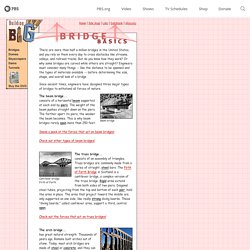

Bridge types - beam structure bridges - beam, cantilever, draw, truss. How Bridges Work" We are a species of bridge builders.

Since time out of mind, humans have engineered structures to surmount obstacles, such as, say, Jiaozhou Bay. The body of water is now home to a 26.4-mile (42.5-kilometer) bridge that links the busy Chinese port city of Quingdao to the Chinese suburb of Huangdou. We've tamed steel, stone, lumber and even living vegetation, all in an effort to reach the places, people and things we desire. Although the concept itself is as simple as felling a tree across a creek, bridge design and construction entails serious ingenuity. Artists, architects and engineers pour vast resources into bridge construction and, in doing so, reshape the very environment in which we live. As a result, we inhabit a planet of bridges, some as ancient as Greece's 3,000-year-old Arkadiko bridge or as unchanged as India's 500-year-old Meghalaya living bridges, which are coaxed into existence from growing tree roots (more on that later).
First up, let's get right down to the basics. BUILDING BIG: Bridge Basics. There are more than half a million bridges in the United States, and you rely on them every day to cross obstacles like streams, valleys, and railroad tracks.

But do you know how they work? Or why some bridges are curved while others are straight? Engineers must consider many things -- like the distance to be spanned and the types of materials available -- before determining the size, shape, and overall look of a bridge. Since ancient times, engineers have designed three major types of bridges to withstand all forces of nature. The truss bridge... consists of an assembly of triangles. Check out the forces that act on truss bridges! Now that you've mastered the bridge basics, test your bridge-building skills in the Bridge Challenge! Types of Bridges. As of July 1, 2013 ThinkQuest has been discontinued. We would like to thank everyone for being a part of the ThinkQuest global community: Students - For your limitless creativity and innovation, which inspires us all.
Teachers - For your passion in guiding students on their quest. Partners - For your unwavering support and evangelism. Parents - For supporting the use of technology not only as an instrument of learning, but as a means of creating knowledge. We encourage everyone to continue to “Think, Create and Collaborate,” unleashing the power of technology to teach, share, and inspire. Best wishes, The Oracle Education Foundation. Bridge. Etymology The Oxford English Dictionary traces the origin of the word bridge to an Old English word brycg, of the same meaning, derived from the hypothetical Proto-Germanic root brugjō. There are cognates in other Germanic languages. History The first bridges were made by nature itself — as simple as a log fallen across a stream or stones in the river. The first bridges made by humans were probably spans of cut wooden logs or planks and eventually stones, using a simple support and crossbeam arrangement.